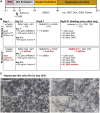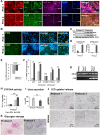Forskolin induces FXR expression and enhances maturation of iPSC-derived hepatocyte-like cells
- PMID: 38694820
- PMCID: PMC11061433
- DOI: 10.3389/fcell.2024.1383928
Forskolin induces FXR expression and enhances maturation of iPSC-derived hepatocyte-like cells
Abstract
The generation of iPSC-derived hepatocyte-like cells (HLCs) is a powerful tool for studying liver diseases, their therapy as well as drug development. iPSC-derived disease models benefit from their diverse origin of patients, enabling the study of disease-associated mutations and, when considering more than one iPSC line to reflect a more diverse genetic background compared to immortalized cell lines. Unfortunately, the use of iPSC-derived HLCs is limited due to their lack of maturity and a rather fetal phenotype. Commercial kits and complicated 3D-protocols are cost- and time-intensive and hardly useable for smaller working groups. In this study, we optimized our previously published protocol by fine-tuning the initial cell number, exchanging antibiotics and basal medium composition and introducing the small molecule forskolin during the HLC maturation step. We thereby contribute to the liver research field by providing a simple, cost- and time-effective 2D differentiation protocol. We generate functional HLCs with significantly increased HLC hallmark gene (ALB, HNF4α, and CYP3A4) and protein (ALB) expression, as well as significantly elevated inducible CYP3A4 activity.
Keywords: Forskolin; cytochrome P450 activity; hepatocyte-like cells (HLCs); in vitro Differentiation; induced pluripotent stem cells (iPSCs).
Copyright © 2024 Loerch, Szepanowski, Reiss, Adjaye and Graffmann.
Conflict of interest statement
The authors declare that the research was conducted in the absence of any commercial or financial relationships that could be construed as a potential conflict of interest. The author(s) declared that they were an editorial board member of Frontiers, at the time of submission. This had no impact on the peer review process and the final decision.
Figures


Similar articles
-
Identification of an FXR-modulated liver-intestine hybrid state in iPSC-derived hepatocyte-like cells.J Hepatol. 2022 Nov;77(5):1386-1398. doi: 10.1016/j.jhep.2022.07.009. Epub 2022 Jul 19. J Hepatol. 2022. PMID: 35863491
-
Improvements in Maturity and Stability of 3D iPSC-Derived Hepatocyte-like Cell Cultures.Cells. 2023 Sep 27;12(19):2368. doi: 10.3390/cells12192368. Cells. 2023. PMID: 37830581 Free PMC article.
-
Hepatocyte-like cells derived from human induced pluripotent stem cells using small molecules: implications of a transcriptomic study.Stem Cell Res Ther. 2020 Sep 11;11(1):393. doi: 10.1186/s13287-020-01914-1. Stem Cell Res Ther. 2020. PMID: 32917265 Free PMC article.
-
A comprehensive transcriptomic comparison of hepatocyte model systems improves selection of models for experimental use.Commun Biol. 2022 Oct 14;5(1):1094. doi: 10.1038/s42003-022-04046-9. Commun Biol. 2022. PMID: 36241695 Free PMC article.
-
Derivation and applications of human hepatocyte-like cells.World J Stem Cells. 2019 Aug 26;11(8):535-547. doi: 10.4252/wjsc.v11.i8.535. World J Stem Cells. 2019. PMID: 31523372 Free PMC article. Review.
Cited by
-
Human-Induced Pluripotent Stem Cells (iPSCs) for Disease Modeling and Insulin Target Cell Regeneration in the Treatment of Insulin Resistance: A Review.Cells. 2025 Aug 1;14(15):1188. doi: 10.3390/cells14151188. Cells. 2025. PMID: 40801620 Free PMC article. Review.
References
-
- Baumann G., Felix S., Sattelberger U., Klein G. (1990). Cardiovascular effects of forskolin (HL 362) in patients with idiopathic congestive cardiomyopathy--a comparative study with dobutamine and sodium nitroprusside. J. Cardiovasc Pharmacol. 16 (1), 93–100. 10.1097/00005344-199007000-00013 - DOI - PubMed
LinkOut - more resources
Full Text Sources
Miscellaneous

